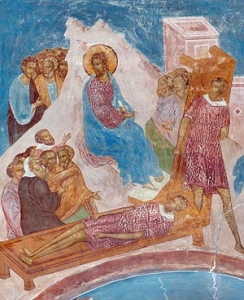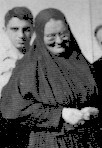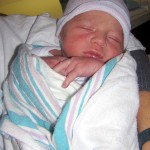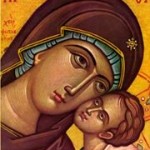This week our Church commemorates the Sunday of the Paralytic. The Gospel reading is taken from St. John 5, 1 – 15. One thing struck me after I read this passage. Aren’t all of us paralyzed in one way or the other? The young man in the Gospel account was physically impaired for many years, but he never gave up on the possibility of being healed. He waited by the pool for thirty-eight years for his deliverance.
Many of us who are paralyzed spiritually, emotionally or psychologically sit by the side of life. There may be limitations to our understanding, we may not be able to move past a scar on our heart, perhaps we cannot forgive some hurt we have experienced. Do we live our life trying to be healed or trying to ignore our malady? The question that Christ asked the young man is very pertinent to our own circumstances or powerlessness, “Do you want to be healed?” At first, the obvious response would be an indignant, “of course,” but many of us wear our debilitation as a badge of identity. Not too many weeks ago, we were anointed with the sacrament Holy Unction. While we were being anointed, the invocation reminded us that Christ is the physician of our souls and bodies. Souls and bodies, we are told that the young man needed physical healing. Nonetheless, waiting next to the pool for thirty-eight years to be healed must have left emotional scars on the young man. As we analyze all the miracles of Christ, He heals each person whom He encounters; provided that the person turns him in faith. The healing always restores the person to wholeness. So, it is understood that all aspects of this paralyzed man was healed.
Turning to Christ in faith is not a magic formula. Wholeness involves the restoration of our spirit. This restoration may impart to us the capacity to recognize our paralysis, to understand its cause and to start on a path to wellness. Its possible physical limitations remain with us to illumine our heart to overcome the deeper emotional weakness. The healing of Christ is a mystery as is the opportunity to witness His love in our life. Our witness, like the young man’s in the temple, is the acknowledgement that God is working to transform our heart.
]]>

 [/caption]
She strongly wished to continue a monasticism open to the world in the manner of Alexander Bukharev. In the 1930s she reached out to the suffering poor of Paris. A controversial socially active monasticism caused a scandal with more conservative church members, but Mother Maria endured. With the advent of World War II, Mother Maria and her friends reached out to help Jews hide and escape Nazi persecution. She was betrayed to the Germans and was put to death, taking the place of a young girl scheduled to die in the gas chambers. Her martyrdom took place in the last days of the war in Ravensbruck concentration camp; On January 18, 2004, the Holy Synod of the Ecumenical Patriarchate in Istanbul recognized Mother Maria Skobtsova as a saint along with her son Yuri, the priest who worked closely with her, Fr. Dimitri Klépinin, and her close friend and collaborator Ilya Fondaminsky. All four died in German concentration camps. On January 18, 2004, the Holy Synod of the Ecumenical Patriarchate in Istanbul recognized Mother Maria Skobtsova as a saint along with her son Yuri, the priest who worked closely with her, Fr. Dimitri Klépinin, and her close friend and collaborator Ilya Fondaminsky.]]>
[/caption]
She strongly wished to continue a monasticism open to the world in the manner of Alexander Bukharev. In the 1930s she reached out to the suffering poor of Paris. A controversial socially active monasticism caused a scandal with more conservative church members, but Mother Maria endured. With the advent of World War II, Mother Maria and her friends reached out to help Jews hide and escape Nazi persecution. She was betrayed to the Germans and was put to death, taking the place of a young girl scheduled to die in the gas chambers. Her martyrdom took place in the last days of the war in Ravensbruck concentration camp; On January 18, 2004, the Holy Synod of the Ecumenical Patriarchate in Istanbul recognized Mother Maria Skobtsova as a saint along with her son Yuri, the priest who worked closely with her, Fr. Dimitri Klépinin, and her close friend and collaborator Ilya Fondaminsky. All four died in German concentration camps. On January 18, 2004, the Holy Synod of the Ecumenical Patriarchate in Istanbul recognized Mother Maria Skobtsova as a saint along with her son Yuri, the priest who worked closely with her, Fr. Dimitri Klépinin, and her close friend and collaborator Ilya Fondaminsky.]]>  [/caption]
Our prayer should be: “O my God, here is my hand!”]]>
[/caption]
Our prayer should be: “O my God, here is my hand!”]]>  [/caption]
When we learned the baby was going to be a boy he acquired a name, Peter Nicholas. The little guy was going to be named for his two uncles, one on each side of the family. Little Peter has been a topic of great speculation. When exactly would he come, how much he would weigh, how big would he be? Well, today we got all our questions answered. He made his appearance on February 21, 2009, he is 191/2” long and he weighs 7.4lbs.
[/caption]
When we learned the baby was going to be a boy he acquired a name, Peter Nicholas. The little guy was going to be named for his two uncles, one on each side of the family. Little Peter has been a topic of great speculation. When exactly would he come, how much he would weigh, how big would he be? Well, today we got all our questions answered. He made his appearance on February 21, 2009, he is 191/2” long and he weighs 7.4lbs.
 We need to be open to God’s love, to allow it to permeate our soul and to have appreciation for it when it comes. This can happen not only in the big events, like the birth of a new baby; but in the little things. That is the challenge, stopping to recognize God revealing Himself and His love to us and letting that blessing soften our heart and bring joy into our life. Look at your life. Has God revealed Himself and His love to you? Maybe He has, but you were too busy or preoccupied to notice. The pace of life is so fast that many times we can not recognize the love of God. It may be that small event, that person we meet or the opportunity to open our own heart; yet we do not cherish the moment or perceive the encounter with the love of God. St Silouan the Athonite prayed, “O Lord, by Your Holy Spirit enlighten Your people that all may know Your love.”
We need to be open to God’s love, to allow it to permeate our soul and to have appreciation for it when it comes. This can happen not only in the big events, like the birth of a new baby; but in the little things. That is the challenge, stopping to recognize God revealing Himself and His love to us and letting that blessing soften our heart and bring joy into our life. Look at your life. Has God revealed Himself and His love to you? Maybe He has, but you were too busy or preoccupied to notice. The pace of life is so fast that many times we can not recognize the love of God. It may be that small event, that person we meet or the opportunity to open our own heart; yet we do not cherish the moment or perceive the encounter with the love of God. St Silouan the Athonite prayed, “O Lord, by Your Holy Spirit enlighten Your people that all may know Your love.”